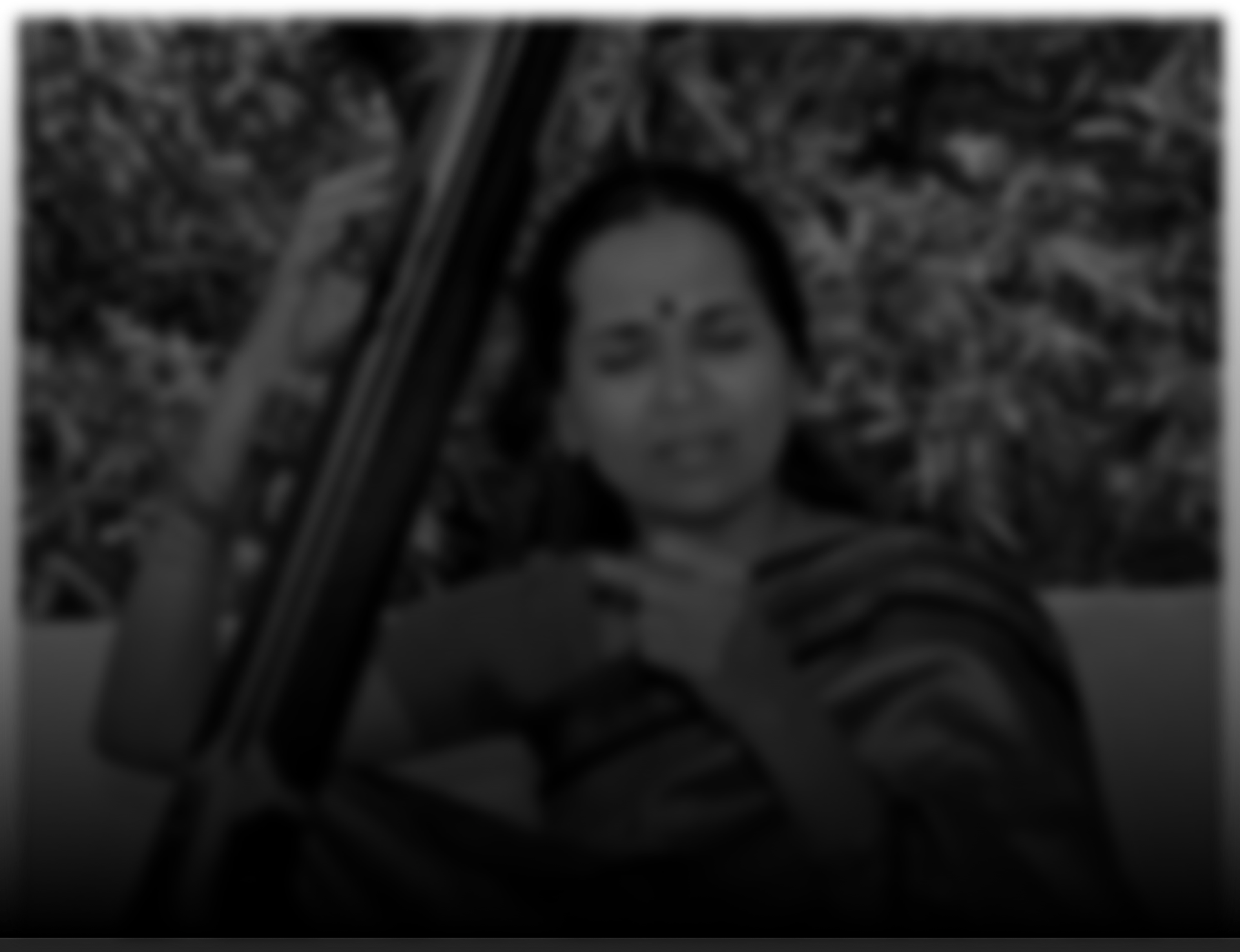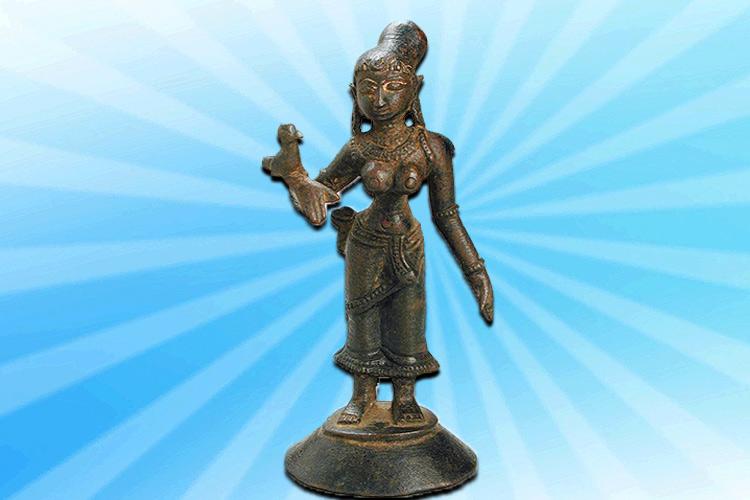Andal and Meera – Loving the Dark Hued God
Just because they were women, and loved the dark hued lord and sang in the idiom of bridal mysticism, do Andal and Meera invite comparison?
ghUnghata kA paTa khol rI, tohe piyA milEnge,
That bridal veil
Move it aside
Your lover you will find.
When Kabir sang this song, it was as if he, like a “ventriloquist, inhabited the body of a fictive woman, shaping her, and lending her the willed voice of his body” (1). But in Meera and Andal it is their own voices and their own bodies. And how different are the two voices.
Meera’s songs seem to come from the dark of the heart(2) – they speak of her defiance, her obstinacy, her mad quest. And always, they resonate with a searing loneliness.
Log kahE mIra bhayI bAwarI sAs kahE kulanAsI rE
paga ghunghuru bAndha mIra nAchi re.
People say Meera has gone mad
Mother-in-law says I bring disgrace to the family.
I, Meera, dance.
She loved as she should not have. Love for the dark hued one was alright but to say:
Mein to giridhar ke ghar jaoon / giridhar mhAro sAcho prItam
At nightfall
I will skip
To his door
Be lit
By his face (3)
And then to dance among other devotees, other men, even if sadhus! This was beyond disgracing the family’s honour. A married woman, married into royalty no less, and then widowed! What but pious isolation could be her destiny. But she says defiantly:
Your highness
Now you can’t close me
With walls
The wise are now dear to me, lost
Is womanly shame, I ‘ve left
My mother’s house
And the taste of dance is on my tongue. (4)
Defiant! In love! Lonely!
Andal’s seems a brighter world. She is surrounded by a family where love, and love for Narayanan was the most precious gift. She was fierce in her love and no one stopped her. She wanted to be wed to Him, and even that was not a problem. Her father, Visnuchittar, describes the 108 manifestation of Narayana and asks her which of these she wants to marry.
But she too suffered – an unrelenting lover, and her obstinacy that she would wed nobody but Him. The Nachiyar Tirumozhi depicts her intense journey of love, suffering separation, pining for Him, observing the Manmatha vratam who, as the god of love, she pleads, must unite her with her lord. Yearning, hoping, pleading with the cuckoo and the clouds to carry her message, imploring her relatives when she is too weakened by suffering to take her to where He danced on that serpent’s hood, to the banks of Yamuna, to the courtyard of Nanda, asking for a piece of His clothing to be wrapped around her to soothe her burning desire, despairing, wilting away, hoping again… Such is her agony.
How could she pray to another god? Manmatha? Orthodox Vaishnava commentaries have agonized over this, tried to brush it aside, explain it with a hundred sophistries. But Andal cared not for canon. Flying into the mythic world of Brindavan she asks Kannan not to destroy the sand castles she and the other gopi-s have built for Manmatha. What paradox this! She prays to Manmatha for union with Kannan and yet when He is there she chides Him to leave intact her sand castles.
It is only in the world of myth (she and her friends in Brindavan protecting their sandcastles from the playful Krishna) or in dream (a thousand elephants herald the coming of Kannan to marry her) that she meets Him. Flitting between the worlds of her own unyielding reality and myth and dream where she meets Him, her inner world appears almost fractured.
Meera, astonishingly, has almost nothing to do with Krishna’s mythic persona – the cowherd who teased the gopis, slayer of Kamsa, friend of Arjuna and Sudama – she has very little to do with those. It is as if she has claimed Him for herself, not for His prowess, His pranks and His conquests, but simply for His form – the beauty of his form. And of his mythic persona it is only these that she appropriates. That alluring dark hue, that teasing peacock feather, that rich yellow garment, that maddening flute, those dancing earrings…. His bewitching form and her hungry eyes tell the story of her love.
AalI rI mhAre nainA bAN paDI
My eyes have been pierced
That beautiful form
Ensconced in my heart…
For Meera this is whom she waits for – her Giridhar Gopal, not of any particular temple or manifestation, but perhaps that which, as legend has it, she sees and holds everyday in the form of the idol she has loved since her childhood.
Andal pleads with the myriad forms of Narayana – Venkatan of the Tiruvenkadam hills, Sundararaja Perumal of the TirumAliruncholai – in the true tradition of Vaishnavism. She also draws imagery, motifs and metaphors from the passionate Sangam poetry – erotic imagery too.
O clouds spread like blue cloth
Across the vast sky –
Has Tirumal, my beautiful lord
Of Venkatam
Where cool streams leap
Come with you?
My tears gather and spill between my breasts
Like waterfalls
He has destroyed my womanhood
How does this bring him pride? (5)
She rebukes the peacock for dancing in front of her reminding her of Him, the Kovai fruit for reminding her of His red lips, of the clouds for reminding her of His majestic form and she pleads with the panchajanya, the conch, to tell her
karpuramum narumo kamalpoo narumo
How does it smell?
His Mouth?
Is it of camphor?
A fresh lotus?
While Meera’s songs lay bare her heart, her desire, they are bereft of overt sexual imagery of the kind Andal freely employs. Meera had enough battles to fight without inviting censure on another count!
What is it to love Krishna the way these two did? Is it possible to get under their skin – even for a moment? Pleading to Krishna to come to them, like a lovelorn woman would her lover, waiting for Him, and when He doesn’t come, setting off in search of Him? What is it to be like this? What is the mystic’s call? Can one snatch even a mere glimpse of this or does one have to die to this world and take that leap of faith where the only things certain are the world you are dying to and the fire of desire in your heart?
Meera says:
kathina saawaliya kI priita
Laage so hi jaane
What is it to be hurt?
You know when you are hurt.
What is it to burn in the jauhar?
You know when you burn.
What is it to love sanwariya?
You know when you love.
It is difficult.
To love Him.
It is difficult.
Restlessness – that is the inescapable fate of mortals. Some cannot take it. And set off in mad, impossible quests. In the real world God “is present only in his absence” (6) and nowhere is this more poignantly, and variedly, brought home than in these songs of Andal and Meera.
- Susan Stewart: Poetry and the Fate of the Senses, quoted by Archana Venkatesan in “A Woman’s Kind of Love: Female Longing in Tamil Alwar Poetry; Journal of Hindu Christian Studies.
- Shama Futehally: Songs from the Dark of the Heart; Harper Collins
- Futehally, ibid
- Futehally, ibid
- Archana Venkatesan, ibid
- Suguna Ramanathan in an eloquent foreword to Shama Futehally, ibid.
Published in Aalaap.

